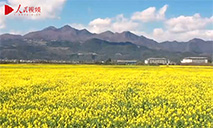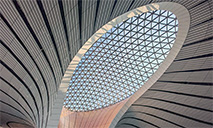Xi Focus-Closeup: From arid land to oasis
BEIJING, March 25 (Xinhua) -- In the spring of 1997, Huang Tongshuai, an 11-year-old at the time, saw a group of adults talking around a well in his village, located in an area called Xihaigu in northwest China's Ningxia Hui Autonomous Region.
Out of curiosity, he went close to see what was happening. He learned that those "adults from Fujian" planned to help the villagers dig more small round wells.
He had no idea that the lives and fates of numerous villagers would change after that.
Among the group of people was Xi Jinping, then deputy secretary of east China's Fujian Provincial Committee of the Communist Party of China (CPC), who was in charge of a "pairing-up" poverty alleviation program between Fujian and Ningxia.
That trip was his first visit to Xihaigu, an arid land once labeled the "most unfit place for human settlement" by visiting experts from the United Nations in the 1970s due to drought and fragile ecological environment.
When he visited Xihaigu again after almost two decades in 2016, Xi still remembered one household he visited: "It was completely destitute, with hardly anything of value. I saw a small bundle of wild vegetables suspended by a rope from the ceiling. It was perhaps the family's only valuable item. Water was so scarce that the villagers could hardly have showers."
During the trip, Xi noted that water shortages were the primary cause of poverty in Xihaigu. To address the problem, Xi called for efforts to make good use of water -- "waters from the sky, on earth and underground."
For over 20 years, Fujian helped Ningxia build around 15,000 wells and cisterns, providing drinking water for 300,000 people. The wells are known to residents as "life-saving wells."
Xi also pushed for a relocation project, which saw whole communities from Xihaigu move from their barren, inhospitable ancestral lands to a new area at the foot of Helan Mountain nourished by the Yellow River. Xi named the area "Minning," a portmanteau of the abbreviations of Fujian and Ningxia.
Thanks to policies such as relocation of communities, grazing bans, and the regreening of farmland, Ningxia's forest coverage rate increased from 1.5 percent in 1958 to 15.8 percent in 2020, with the forest area exceeding 820,000 hectares.
During his visit in 2016, Xi, general secretary of the CPC Central Committee, Chinese president and chairman of the Central Military Commission, met with Xie Xingchang, a villager of Minning.
Xie happily told Xi that improvements happened in his family every day over the past two decades.
Xie still remembered the first day when the building of the village started. "I gleaned some corn cobs and sorghum ears from nearby farms. I took them back and showed them to my fellow villagers, telling them that we will have water, and we will be able to grow crops."
Xi has always placed a high value on the ecological conservation and governance of water resources in the country.
In 2020, in another visit to Ningxia, Xi stressed the need to actively develop water-conserving agriculture and refrain from water-wasting irrigation.
The planting structure should be adjusted to better protect the water resources here, Xi said, noting that the people in Ningxia have long been blessed by the Yellow River.
Xi has called for ensuring a blue sky, green mountains and clear rivers all across China, so that children will live in an enjoyable environment. "This is a very important part of the Chinese Dream," Xi said.
Photos
 Increasingly more young adults in China register wills that include virtual assets
Increasingly more young adults in China register wills that include virtual assets Rapeseed flowers turn NW China's Luoping into picturesque spring wonderland
Rapeseed flowers turn NW China's Luoping into picturesque spring wonderland Why do people in China fall for animated characters like LinaBell and Bing Dwen Dwen?
Why do people in China fall for animated characters like LinaBell and Bing Dwen Dwen? Photo Album: architecture in Beijing merging history and modernity
Photo Album: architecture in Beijing merging history and modernity
Related Stories
Copyright © 2022 People's Daily Online. All Rights Reserved.






